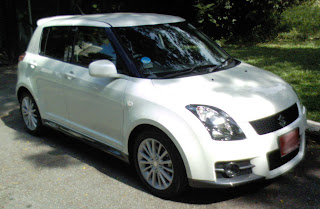Tips on Coping with Jet Lag
 Jet lag, a term that is ever familiar with the frequent travelers. With the world becoming a global village and with the increase in need to travel for work and for other reasons, people are traveling more and more regularly. There is a saying, by some people who are traveling a lot, "I'm taking the plane just like taking a cab."
Jet lag, a term that is ever familiar with the frequent travelers. With the world becoming a global village and with the increase in need to travel for work and for other reasons, people are traveling more and more regularly. There is a saying, by some people who are traveling a lot, "I'm taking the plane just like taking a cab."Jet lag is a physiological condition which is a consequence of alterations to the biological clock, which is a small cluster of brain cells that controls the timing of biological functions (circadian rhythms), including when you eat and sleep. When traveling across a number of time zones, the body clock will not be in sync with the destination time, as it experiences daylight and darkness contrary to the rhythms to which it has grown so used to. Besides being caused by traveling to different time zones on jet as its name implies, jet lag can also be due to shift work, daylight saving time, altered day length. They are known as desynchronosis, dysrhythmia, dyschrony, jet lag, or jet syndrome.
The condition of jet lag may last many days and depends on individuals. People who normally stick to a rigid daily routine, are often the worst sufferers. People whose normal lives involve highly varied routines can often adjust their circadian rhythms better, and adapt to a disruption of normal eating and sleeping patterns. People who sleep easily can also cope better with the adjustment. The intensity of the condition of jet lag also depends on the number of time zones cross. For people flying across only one or two time zones, they may be able to adjust without noticeable effects of the time change as compared to others who are flying across three or more time zones.
Direction of flight will also determine how intense the condition of your jet lag will be. There seems to be some evidence that traveling west to east is the more disruptive. Travelers flying east "lose" time. This disruption to their body clocks affects their meals, sleep, bowel habits, and other daily routines consequently. Travelers flying west "gain" time and usually have an easier time adjusting than eastward travelers.
Symptoms of Jet Lag:
The symptoms of jet lag can be quite varied, though on the whole, an individual may experience the following:
5 Tips to Cope with Jet Lag
Below are some tips which you can use to help you cope with jet lag:
1. Pre-flight: Try to relax and not be too excited or concerned about your trip. Staying in shape also helps you to cope better with jet lag. Whether you are traveling are not, it is always important to stay in tip-top physical condition and that will mean plenty of rest, exercise and eating right. And remember to get a good night of sleep prior to departure.
2. Drink Plenty of Water: As mentioned above, to prevent dehydration, it is important for you to drink plenty of water during the flight. It is advisable not to drink alcohol or even caffeinated beverages before, during, or just after the flight as they not only cause dehydration, but also disrupt your sleeping schedules.
3. Move around on the plane: While seated during your flight, exercise your legs from time to time. For example, moving your legs up and down and back and forth, bending your knees or standing up and sitting down etc. You may also want to take a walk in the aisle every hour or two. This not only prevents blood clot in the legs (which may lead to death in serious cases), but also helps to reduce discomfort and refresh your body. Just don't do jumping jack in the plane, you have caused the plane to 'jump' too. In the event where there are stopovers, do get off the plane wherever possible to do some exercises or take a walk.
4. Wear comfortable shoes and clothes: For once, looking good on the plane is not as important as feeling good. Make sure you are comfortably dress for the flight. Avoid items that pinch, restrict, or chafe. A good point to note is also to keep in mind the climate in your destination.
5. Sleep aids: Blindfolds, ear plugs, neck rests and blow-up pillows are all useful in helping you get quality sleep while flying. Kick your shoes off to ease pressure on the feet (some airlines provide soft sock-like slippers, and many experienced travellers carry their own).
A few words of cautious: some people use sleeping pills to alleviate jet lag. It is highly not advisable as sleeping pills induce a comatose state with little or no natural body movement, and it is well known that prolonged immobility during flight can lead to fatal blood clots (deep vein thrombosis). In addition, many so-called sleeping pills are variants of anti-histamines and they tend to dehydrate significantly, adding to the already significant problem of in-flight dehydration.
Thus with proper planning of your flight in advance by taking notes of your flying direction (whether it is east to west or west to eat), time and coupling with exercises and diet and plenty of rest before the departure can alleviate jet lag. Wishing you a pleasant flight!
Yahoo! Personals 7 Day FREE Trial offer
Labels: biological clock, body clock, circadian rhythms, desynchronosis, different time zones, frequent travelers, jet lag, symptoms of jet lag, tips to cope with jet lag, traveling regularly
 Copyright © 2008 Simon Rosser
Copyright © 2008 Simon Rosser Since the industrial revolution particularly the mid nineteenth century, the burning of fossil fuels for energy to provide electricity, power factories, homes and for all our transport needs has released massive amounts of carbon dioxide (CO2) into the atmosphere. Not only the burning of fossil fuels, but changes in the use of the land for agriculture and deforestation has further added to global manmade CO2 levels. According to the World Wildlife fund some 29 gigatons which is 29 billion metric tons of CO2 was added to the atmosphere in 2004 alone from burning coal, oil and gas.
Since the industrial revolution particularly the mid nineteenth century, the burning of fossil fuels for energy to provide electricity, power factories, homes and for all our transport needs has released massive amounts of carbon dioxide (CO2) into the atmosphere. Not only the burning of fossil fuels, but changes in the use of the land for agriculture and deforestation has further added to global manmade CO2 levels. According to the World Wildlife fund some 29 gigatons which is 29 billion metric tons of CO2 was added to the atmosphere in 2004 alone from burning coal, oil and gas. added to the atmosphere from the burning of fossil fuels. It is a know scientific fact that higher levels of greenhouse gases, of which CO2 is a component cause a warming of Earth's atmosphere. If CO2 is not kept in check and continues to rise at current levels it will eventually cause Earth's temperature to increase to levels which maybe critical to life on Earth.
added to the atmosphere from the burning of fossil fuels. It is a know scientific fact that higher levels of greenhouse gases, of which CO2 is a component cause a warming of Earth's atmosphere. If CO2 is not kept in check and continues to rise at current levels it will eventually cause Earth's temperature to increase to levels which maybe critical to life on Earth. Down with a cold? Vitamin C may just be what you need. 2 years ago one of my associates told me that she never consulted any doctor when she had cold. She simply increased her Vitamin C intake and usually after about 2 weeks, she would be well again. Well, I'm not telling you to skip the doctor when you have cold in the future but rather to share with an experience what you may do to help yourself to get better faster. If you are one of those who doesn't see a doctor just because of a cold, this can very well be something you can do to help yourself get better in the most naturally way. And remember to have your rest too.
Down with a cold? Vitamin C may just be what you need. 2 years ago one of my associates told me that she never consulted any doctor when she had cold. She simply increased her Vitamin C intake and usually after about 2 weeks, she would be well again. Well, I'm not telling you to skip the doctor when you have cold in the future but rather to share with an experience what you may do to help yourself to get better faster. If you are one of those who doesn't see a doctor just because of a cold, this can very well be something you can do to help yourself get better in the most naturally way. And remember to have your rest too. Cellular Phones and Cellular Phone Technologies have advanced by leaps and bounds since their introduction on the market. Do you still remember the day when the cellular phone looks just like the one on the left? I used to joke with my friends that if we throw that phone at someone, it might just kill the person. Some of you might have even seen water bottles being made to look just like that phone. Those were the days when cellular phone were only carried by the rich and elite who could afford them. I have a friend who used to work as an insurance adviser and due to the needs from work, he was among the first few to carry a cellular phone. He said that he used to go to a quiet corner when using his cellular in public or he would get a lot of passersby looking at him as if to say that he was a show off; who would need a cellular in those days when you can see public phone almost everywhere you go.
Cellular Phones and Cellular Phone Technologies have advanced by leaps and bounds since their introduction on the market. Do you still remember the day when the cellular phone looks just like the one on the left? I used to joke with my friends that if we throw that phone at someone, it might just kill the person. Some of you might have even seen water bottles being made to look just like that phone. Those were the days when cellular phone were only carried by the rich and elite who could afford them. I have a friend who used to work as an insurance adviser and due to the needs from work, he was among the first few to carry a cellular phone. He said that he used to go to a quiet corner when using his cellular in public or he would get a lot of passersby looking at him as if to say that he was a show off; who would need a cellular in those days when you can see public phone almost everywhere you go.
 Communications demands in work and business have spurred the development of advanced communication technologies that allow you to be contactable 24/7. Whenever I see someone using a Blackberry phone, I always remembered what one of my friends said. He is working as sort of a project manager and event organiser and thus he has to be contactable at all time. I remembered when we were having dinner with him, he said that he really envy us and how he wishes he can carry a smaller phone instead of his Blackberry. And as you might have guessed, he carried two phones and he said it's really inconvenient and troublesome at time. Last month we had another dinner gathering and just when we were about to leave the restaurant at around 1030pm, he got a call from one of his contractors informing him that they were hanging up the banner (not the banner we have in the internet) for an upcoming event. They had taken and email him some photos and were calling to check if he had checked his email yet. Cell phone has made work easier in a lot of way and yet it definitely changed our working hours and put a new meaning to the so called 9-to-5 work. How has cell phone changed the way you are doing your work?
Communications demands in work and business have spurred the development of advanced communication technologies that allow you to be contactable 24/7. Whenever I see someone using a Blackberry phone, I always remembered what one of my friends said. He is working as sort of a project manager and event organiser and thus he has to be contactable at all time. I remembered when we were having dinner with him, he said that he really envy us and how he wishes he can carry a smaller phone instead of his Blackberry. And as you might have guessed, he carried two phones and he said it's really inconvenient and troublesome at time. Last month we had another dinner gathering and just when we were about to leave the restaurant at around 1030pm, he got a call from one of his contractors informing him that they were hanging up the banner (not the banner we have in the internet) for an upcoming event. They had taken and email him some photos and were calling to check if he had checked his email yet. Cell phone has made work easier in a lot of way and yet it definitely changed our working hours and put a new meaning to the so called 9-to-5 work. How has cell phone changed the way you are doing your work? The cell phone of yesterday is no longer an item only for the rich and elite. Through the advances in technology, the cell phone has become an affordable item for the common people and our lives can never be the way again. There are no way we can prevent or control the advances in technology and it does not make sense not to embrace these advances if they make our lives easier and better - provided that these advances do not disturb the harmony with the environment we are living in. I remembered a quotation that goes something like this, "We must always love people and make use of technology and not the other way round." On top of that, I must add, "We must love our environment too!" We would not be around if our planet is harm. Wishing all love and goodness in all areas of your life.
The cell phone of yesterday is no longer an item only for the rich and elite. Through the advances in technology, the cell phone has become an affordable item for the common people and our lives can never be the way again. There are no way we can prevent or control the advances in technology and it does not make sense not to embrace these advances if they make our lives easier and better - provided that these advances do not disturb the harmony with the environment we are living in. I remembered a quotation that goes something like this, "We must always love people and make use of technology and not the other way round." On top of that, I must add, "We must love our environment too!" We would not be around if our planet is harm. Wishing all love and goodness in all areas of your life.
 How many times have you heard of the saying, "An apple a day, keeps the doctor away," and yet how many of us are diligently following it. Most probably most of you will say, "Hey, I know that!" There is a saying, "To know and not to do is yet to know." There is another saying in Mandarin that illness comes from what go into our mouth. This is very true to a large extent. In order for us to have a healthier life, we not only have to exercise regularly, we also have to watch our diet. Exercises couple with healthy diet is a slow but sure way to lose that extra pounds too.
How many times have you heard of the saying, "An apple a day, keeps the doctor away," and yet how many of us are diligently following it. Most probably most of you will say, "Hey, I know that!" There is a saying, "To know and not to do is yet to know." There is another saying in Mandarin that illness comes from what go into our mouth. This is very true to a large extent. In order for us to have a healthier life, we not only have to exercise regularly, we also have to watch our diet. Exercises couple with healthy diet is a slow but sure way to lose that extra pounds too.

